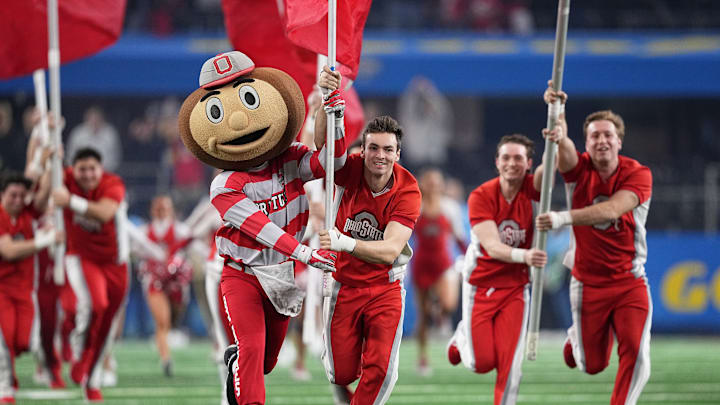Josh Pate’s recent top 15 college football programs for the next three years sparked considerable discussion among fans and analysts.
🚨TOP CFB PROGRAMS: NEXT 3 YRS🚨
— Josh Pate (@LateKickJosh) July 8, 2024
1. UGA
2. Alabama
3. Ohio State
4. Oregon
5. Texas
6. FSU
7. Notre Dame
8. Oklahoma
9. Michigan
10. Texas A&M
11. LSU
12. Tennessee
13. Miami
14. Clemson
15. Penn State
With new head coaches and significant conference realignments, some changes to the list are warranted. Here’s a revised ranking, complete with the reasoning behind the new order and an analysis of each program's potential trajectory.
1. Georgia
Georgia retains the top spot due to their sustained dominance under Kirby Smart. The Bulldogs' elite recruiting and consistent performance make them the standard in college football.
2. Ohio State
Ohio State moves up to second place. Ryan Day’s high-powered offense and strong recruiting pipeline ensure the Buckeyes remain a top contender. Their ability to compete at the highest level year after year is unmatched.
3. Alabama (now with Kalen DeBoer)
Alabama drops to third with Kalen DeBoer taking over. While DeBoer’s success at Washington hints at potential, following Nick Saban’s legacy is no small feat. The Crimson Tide’s strong recruiting and winning culture keep them near the top, but DeBoer’s adaptation to the SEC will be crucial.
4. Michigan (now with Sherrone Moore)
Michigan climbs to fourth under new head coach Sherrone Moore. His familiarity with the program and offensive expertise offer continuity, and the Wolverines’ recent Big Ten success sets a strong foundation. Moore’s ability to handle the big stage will be key.
5. Oregon
Oregon’s move to the Big Ten places them at fifth place. Under Dan Lanning, the Ducks have shown aggressive recruiting and innovative play. Competing in the Big Ten will be a test, especially against powerhouses like Ohio State and Michigan, but they have the potential to thrive.
6. Texas
Texas drops slightly to sixth. Steve Sarkisian has shown promise, but the Longhorns’ ability to handle Big 12 and upcoming SEC competition will be the ultimate test. Their resources and recruiting base are unmatched, but consistent performance is key.
7. LSU
LSU rises to seventh. Brian Kelly’s Tigers are fresh off a strong season, and their recruiting positions them well for the future. Competing consistently with the SEC elite will be crucial for sustained success.
8. Oklahoma
Oklahoma maintains a strong position at eighth under Brent Venables. Their transition to the SEC will be challenging, but the Sooners' offensive legacy and historical success provide a solid foundation.
9. Notre Dame
Notre Dame falls to ninth. Marcus Freeman has kept the Fighting Irish competitive, but breaking through to win a national title remains elusive. Their national reach and recruiting keep them in the mix.
10. Penn State
Penn State climbs to 10th under James Franklin’s steady leadership. The Nittany Lions’ consistent performance and strong recruiting keep them competitive in the Big Ten. Breaking through to the top tier remains their goal.
11. Texas A&M (now with Mike Elko)
Texas A&M drops slightly to 11th with Mike Elko taking over. As a former Aggies defensive coordinator, Elko’s familiarity with the program is a plus, but his lack of head coaching experience is a challenge. The Aggies’ talent-rich roster provides a strong foundation.
12. Tennessee
Tennessee’s return to prominence under Josh Heupel lands them in 12th. The Volunteers’ explosive offense and improved recruiting make them a formidable opponent. Maintaining momentum in the SEC is always challenging.
13. Florida
Florida's inclusion at 13th marks potential for a significant resurgence under Billy Napier. The Gators’ recruiting base and resources are strong, but translating potential into consistent on-field success is key.
14. Ole Miss
Ole Miss, under Lane Kiffin, ranks fourteenth. The Rebels’ offensive dynamics and knack for pulling off significant wins make them a dangerous opponent. Competing in the highly competitive SEC West will be crucial to their staying power.
15. Clemson
Clemson rounds out the list at fifteenth. Dabo Swinney’s program remains strong, but recent struggles and stiffer competition have raised questions. Their ability to adapt and overcome these challenges will be a storyline to watch.
Do these rankings make sense?
Josh Pate’s original list provides a solid foundation, but the recent coaching changes and conference realignments necessitate a fresh look. The new head coaches at Alabama, Michigan, and Texas A&M face the challenge of meeting high expectations while establishing their own legacies. Kalen DeBoer’s transition to Alabama, for example, will be fascinating to watch as he steps into the shadow of Nick Saban. DeBoer’s offensive acumen and success at Washington suggest he has the tools, but the SEC is a different beast.
Similarly, Sherrone Moore’s promotion at Michigan offers continuity, but leading the Wolverines in the ultra-competitive Big Ten is a significant step up. Mike Elko at Texas A&M brings familiarity and defensive expertise, but his lack of head coaching experience could be a hurdle in meeting the Aggies’ lofty goals.
Oregon’s move to the Big Ten introduces an exciting new chapter for the program. Competing against the likes of Ohio State, Michigan, and Penn State will test the Ducks and could redefine their status on the national stage.
Adding Florida and Ole Miss to the list brings a fresh perspective. Florida’s potential resurgence under Billy Napier and Ole Miss’s offense under Lane Kiffin are both compelling narratives. Their success will heavily depend on navigating the treacherous waters of the SEC.
